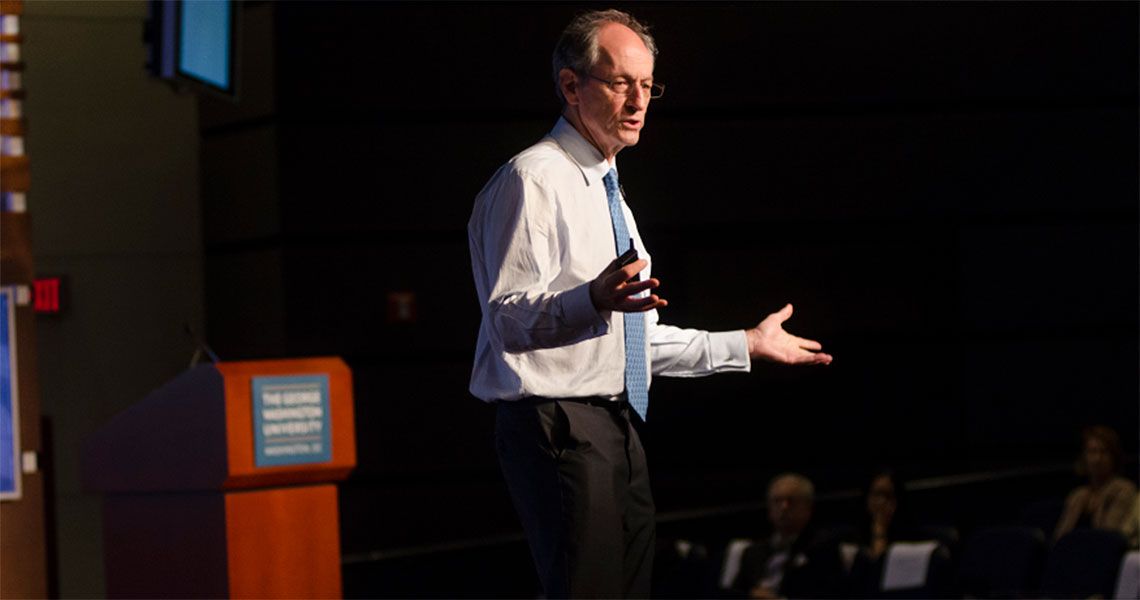Her name was Mary, said Sir Michael Marmot, M.B.B.S., Ph.D., M.P.H., FRCP, FFPHM, FMedSci, professor of epidemiology and public health at University College London and president of the World Medical Association. A 14-year-old First Nations Canadian aboriginal girl, she committed suicide in 2011. She had endured an abusive childhood, and her mother was mentally unstable.
“There is another way to look at Mary’s sadly foreshortened life,” Marmot continued, reading from chapter eight of his recently published book, “The Health Gap: The Challenge of an Unequal World.” “That is to realize that though her personal tragedy was unique, there are many young aboriginal Canadians who experience similar tragedies.”
Over the course of several years, researchers determined that among “bands,” or aboriginal groups, 90 percent of suicides occurred among just 12 percent of bands. “The question is,” Marmot asked, “what distinguished those groups from the others who didn’t have these tragedies?” The answer, he said, was “empowerment.”
Empowerment, which lies at the heart of his book, was the focus of his Nov. 10 lecture, sponsored by the GW School of Medicine and Health Sciences (SMHS) Office of Clinical Practice and Innovation, in partnership with the GW Milken Institute School of Public Health and the GW School of Nursing.
“We’re lucky to have this opportunity to hear from Professor Marmot, to listen to what he has to say, to reflect on it, and ultimately, I hope, to act,” said Lawrence “Bopper” Deyton, M.D. ’85, M.S.H.P., senior associate dean for clinical public health, professor of medicine at SMHS, and discussion panel member. The panel also included Joyce Pulcini, Ph.D., RN, PNP-BC, FAAN, director of community and global initiatives at the GW School of Nursing. “[Marmot’s] early vision and his groundbreaking and continuing work really is a foundation for what I think is our current understanding of the pivotal role of social status, of income, of education, and of community factors related to health and disease,” Deyton added.
Eliot Sorel, M.D., clinical professor of psychiatry and behavioral sciences at SMHS and a close friend of Marmot’s, believes Marmot’s message is not only powerful, but effective. “We conceived of this [lecture] as a beginning,” Sorel said. “What we envision is for us, across disciplines, to think about what other projects we can do together to narrow and eventually close the gap that exists in health at local, national, and global levels.”
The key to eliminating that health gap — empowerment — could be illustrated in the case of Mary and the Canadian bands, Marmot said. Researchers found that cultural and community factors — self-government, land claim participation, health services, and education, to name a few — correlated to a lower suicide rate.
In another example, Marmot discussed two young men in Baltimore. “LeShawn” lived in the Upton/Druid neighborhood, which has mainly single-parent families and an average annual family income of $17,000, and from which 90 percent of high school students do not go to college. LeShawn’s life expectancy is 63. In contrast, “Bobby” lived in the leafy neighborhood of Roland Park. There, 93 percent of households have two-parent families, the average income is $90,000, and 75 percent of high school students go on to complete college. Bobby’s life expectancy: 83. Marmot was not surprised that rioting occurred in Baltimore, though he believes race was not a determining factor; similar rioting took place in Glasgow, a largely homogeneous city.
“I don’t think that riots cause ill health, and I don’t think ill health causes riots,” he said. “I think social disadvantage causes both ill health and unrest. Inequality strains the binds of a cohesive society, and in Baltimore, they snapped.”
What is challenging, Marmot said, is that the almost unbreakable cycles of child poverty, general impoverishment, and underpaid jobs need to become breakable. Early childhood development is crucial, as are livable wages and education. Children who are educated, for example, earn higher incomes, narrowing the income gap and subsequently the health gap, which improves life for their progeny.
“The greater the income inequality, the greater the distance between the rungs of the ladder, the more difficult it is for the next generation to get from one rung to the next,” Marmot said. “That threatens the very nature, the very legitimacy of a democratic society. If my kids don’t have a chance because they’re my kids, that’s not right.”
Empowering women, especially through education, Marmot added, is also critical. He spoke of Lalta, a woman from India who worked as a human scavenger. Her job was to clean human excrement from dry latrines and place it in a reed basket, which she carried on her head to a dumping ground. When non-governmental organization (NGO) Sulabh International installed low-cost sanitation systems in India, and public toilets took the place of dry latrines, Lalta’s life changed. Rather than leave her to face unemployment, the NGO retrained Lalta; she’s now a beautician, earning twice what she did before.
“If we can improve things for the Laltas of the world, by golly we can improve things for the underbelly of our societies,” Marmot said. “I’ve got examples from around the world showing that people are addressing conditions that make people ill and reducing inequities in health within and between countries. Really, we can do it, and we are doing it.”



